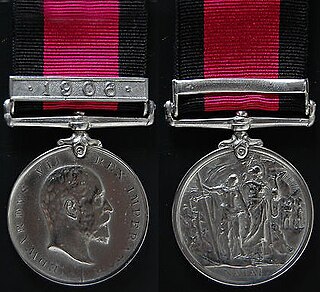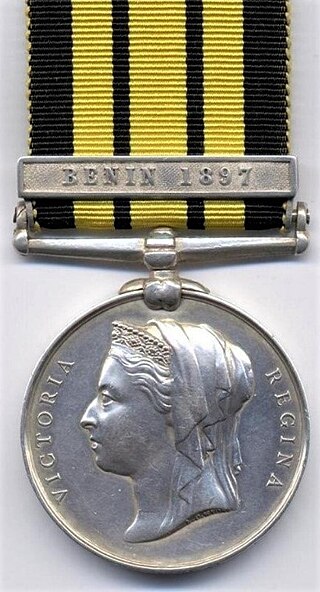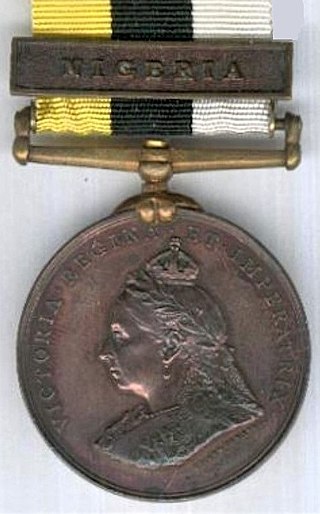
Major Francis Edward Henry Farquharson VC was a Scottish recipient of the Victoria Cross, the highest and most prestigious award for gallantry in the face of the enemy that can be awarded to British and Commonwealth forces.
The Ghana Regiment is an infantry regiment that forms the main fighting element of the Ghanaian Army (GA).
British campaign medals are awarded to members of the British Armed Forces, Allied forces and civilians participating in specified military campaigns. Examples include the Defence Medal, for homeland defence in World War II, and the Atlantic Star for World War II sea service in the Atlantic.

The South Africa Medal (1853) is a campaign medal instituted in 1854, for award to officers and men of the Royal Navy, British Army and locally recruited Cape Mounted Riflemen, who served in the Cape of Good Hope during the Xhosa Wars between 1834 and 1853.

The Anglo-Ashanti wars were a series of five conflicts that took place between 1824 and 1900 between the Ashanti Empire—in the Akan interior of the Gold Coast—and the British Empire and its African allies. The wars were mainly due to Ashanti attempts to maintain and enforce their imperial control over the coastal areas of present-day Ghana, where peoples such as the Fante and the Ga had come under the protection of the British. Although the Ashanti emerged victorious in some of these conflicts, the British ultimately prevailed in the fourth and fifth conflicts, resulting in the complete annexation of the Ashanti Empire by 1900.

The Cape of Good Hope General Service Medal is a British campaign medal which was awarded to members of the Cape Colonial Forces who took part in three campaigns in and around the Cape of Good Hope, in Basutoland in 1880–1881, in Transkei in 1880–1881 and in Bechuanaland in 1896–1897.

The Natal Native Rebellion Medal was a British campaign medal. It was authorised in 1907 for service in Natal during a Zulu revolt against British rule and taxation in 1906. The 1906 Clasp to the medal was awarded to those who had served for more than fifty days.

The Queen's South Africa Medal is a British campaign medal awarded to British and Colonial military personnel, and to civilians employed in an official capacity, who served in the Second Boer War in South Africa. Altogether twenty-six clasps were awarded, to indicate participation in particular actions and campaigns.

The King's South Africa Medal is a British campaign medal awarded to all British and Colonial military personnel who served in the Second Boer War in South Africa, and who were in the theatre on or after 1 January 1902 and who had completed 18 months service in the conflict prior to 1 June 1902.

The East and Central Africa Medal, established in February 1899, was a British campaign medal awarded for minor military operations in the Uganda Protectorate and Southern Sudan between 1897 and 1899. Four separate clasps were issued.

The East and West Africa Medal, established in 1892, was a campaign medal awarded for minor campaigns that took place in East and West Africa between 1887 and 1900. A total of twenty one clasps were issued.

The South Africa Medal (1880), often referred to as the Zulu War Medal, is a campaign medal instituted in 1880 and awarded by the British Government to members of the British Army, Royal Naval Brigade and Colonial Volunteers who were involved in a series of South African tribal wars in the Cape of Good Hope, Colony of Natal and Transvaal between 1877 and 1879, most notably for the Anglo-Zulu War of 1879.

The Africa General Service Medal, established in 1902, was a campaign medal of the United Kingdom. It was awarded for minor campaigns that took place in tropical Africa between 1900 and 1956, with a total of forty five clasps issued. The medal is never seen without a clasp and some are very rare. Most medals were granted to British led local forces, including the King's African Rifles and the West African Frontier Force. The only campaigns where European troops were present in any numbers were the various Somaliland campaigns,, and in Kenya.

The Queen's Sudan Medal was authorised in March 1899 and awarded to British and Egyptian forces which took part in the Sudan campaign between June 1896 and September 1898.

The Ashanti Star was created in 1896 for the members of the expedition against the Ashanti King Prempeh, in the Fourth Anglo-Ashanti War that lasted from December 1895 to February 1896.

The Ashanti Medal was sanctioned in October 1901 and was the first campaign medal authorised by Edward VII. This medal was created for those troops engaged in the Third Ashanti Expedition, also known as the War of the Golden Stool. This expedition lasted from March – December 1900, with the final outcome that the Ashanti maintained its de facto independence. Ashanti was made a Protectorate of the British Empire, but they ruled themselves with little reference to the colonial power.

The Jellalabad Medal was a campaign medal issued by the British East India Company. It was established by Lord Ellenborough, the Governor-General of India, on 30 April 1842.
The medal was awarded for the defence of Jalalabad from 12 November 1841 to 7 April 1842, during the First Afghan War, to the troops under the command of Sir Robert Sale. About 2,600 soldiers took part, including the 13th Foot, the 35th Bengal Native Infantry, as well as detachments from other Indian Army units and some loyal Afghan forces.

The Central Africa Medal was a British campaign medal awarded for service from 1891 to 1894 in Eastern and Central Africa, and from 1894 to 1898 for service in British Central Africa.

The Royal Niger Company’s Medal was a campaign medal issued in 1899 by the Royal Niger Company for service in minor military operations in Nigeria between 1886 and 1897. The award was approved by the British government and could be worn by British servicemen.

Robert Home, was an English officer in the British Army, rising to the rank of colonel in the Royal Engineers. After ably reporting on the defence of the Canadian frontier in 1864, impressing the authorities, he was appointed deputy-assistant quartermaster-general at Aldershot in 1866 and secretary of the Royal Engineers standing scientific committee in 1870, and entered the topographical department of the War Office in 1871. Promoted to major, he was commanding Royal Engineer during the Ashantee War of 1873. He was appointed assistant quartermaster-general at headquarters in 1876, reported on the defences of Constantinople during the Russo-Turkish War, and was breveted colonel. He published A Précis of Modern Tactics in 1873.



















